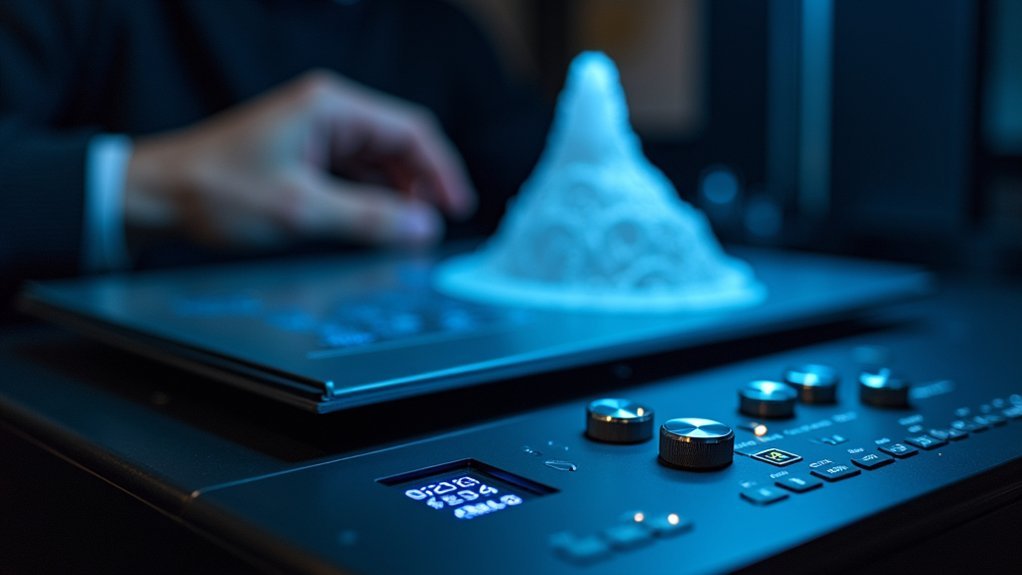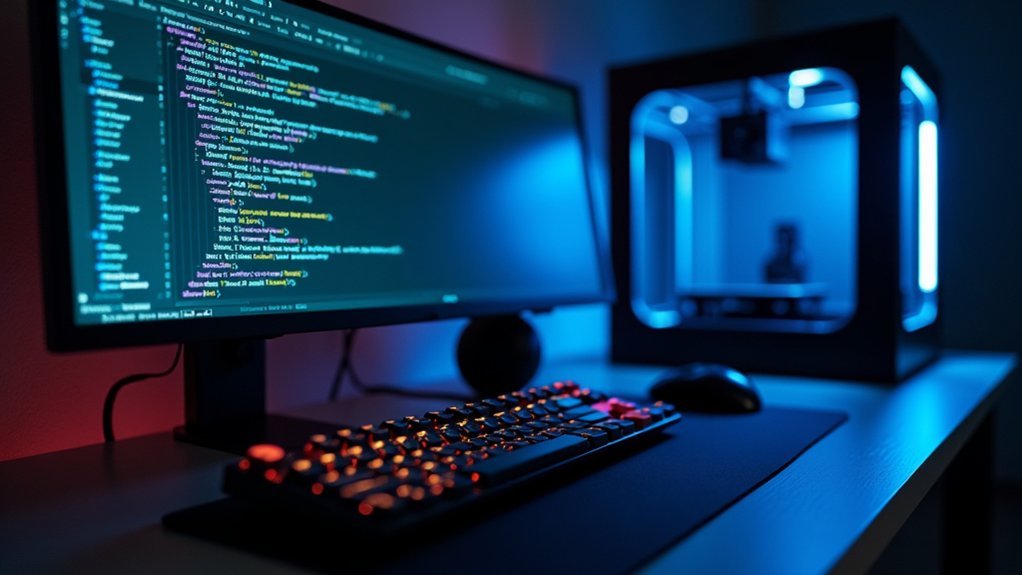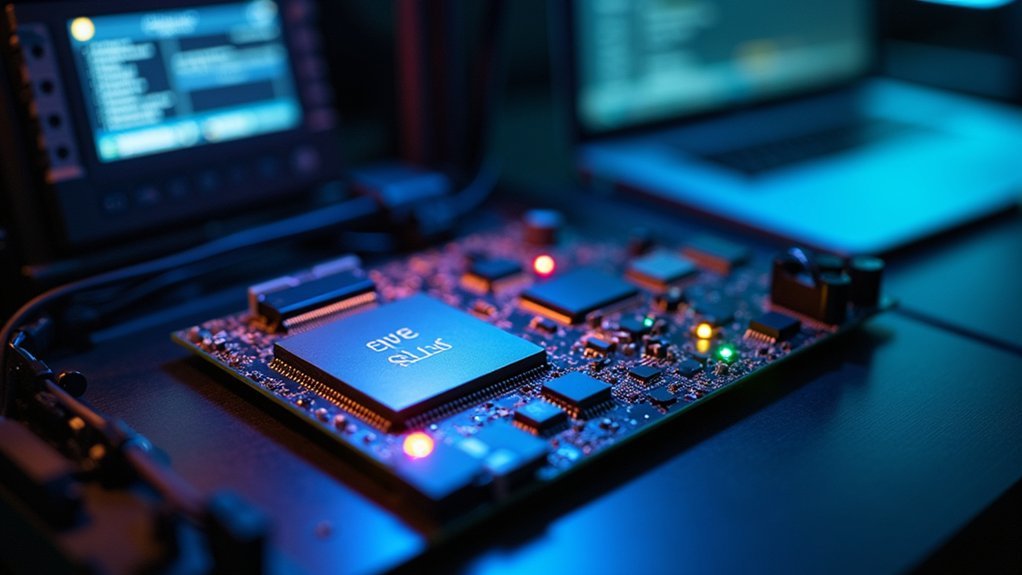You’ll configure firmware print acceleration using M204 commands to set printing, travel, and retract accelerations independently. Start by defining maximum limits with M201 for each axis, then adjust your Configuration.h file’s DEFAULT_ACCELERATION values. Use M204 P[value] for print acceleration, testing conservative values first and gradually increasing while monitoring for vibrations or layer shifting. Save successful settings to EEPROM with M500 to guarantee persistence. The optimization process varies considerably based on your specific printer hardware configuration.
Understanding M204 Command Parameters and Their Functions

The M204 command controls your 3D printer’s acceleration parameters across three distinct movement types.
M204 gives you precise control over your 3D printer’s acceleration across printing, retract, and travel movements.
You can adjust printing acceleration (Paccel), retract acceleration (Raccel), and travel acceleration (Taccel), all measured in mm/s/s. Each parameter works independently, letting you fine-tune acceleration settings for specific movements during printing.
You’ll find that M204 replaced the deprecated Saccel parameter, providing better clarity and functionality.
For example, `M204 P2400` sets printing acceleration to 2400 mm/s/s, while `M204 R1200` adjusts retract acceleration to 1200 mm/s/s. This targeted approach gives you precise control over your printer’s performance.
To monitor current settings, simply send M204 without parameters, and your printer will display all active acceleration values for easy reference.
Configuring Maximum Acceleration Limits With M201
Maximum acceleration limits act as critical safety boundaries that prevent your 3D printer from exceeding its mechanical capabilities. The M201 command defines these limits for each axis, ensuring smooth operation without skipped steps or mechanical damage.
To configure maximum acceleration with M201, you’ll set values for X, Y, Z, and E axes. For instance, `M201 X5000 Y5000` establishes 5000 mm/s² limits for horizontal movements.
Follow these steps for ideal configuration:
- Start with conservative values below your printer’s specifications
- Test print quality while gradually increasing acceleration limits
- Monitor for skipped steps, layer shifting, or unusual noises
- Save successful settings to EEPROM using M500 command
Always prioritize mechanical safety over speed when establishing maximum acceleration boundaries for reliable printing performance.
Setting Default Acceleration Values in Configuration.h

While M201 commands control runtime acceleration limits through G-code, Configuration.h settings establish the fundamental acceleration values that your printer uses as defaults from startup.
Configuration.h establishes your printer’s fundamental acceleration defaults, while M201 commands provide runtime control through G-code.
You’ll configure these baseline settings by defining `#define DEFAULT_ACCELERATION 1000` to set printing acceleration in mm/s² for all axes.
For axis-specific control, use `#define DEFAULT_MAX_ACCELERATION{ X, Y, Z, E }`, replacing each letter with your desired values.
You can further refine X and Y axes independently with `#define MAX_X_ACCEL 2000` and `#define MAX_Y_ACCEL 2000`.
Don’t forget to adjust travel moves using `#define DEFAULT_TRAVEL_ACCELERATION 1000` for faster non-printing movements.
Always verify your acceleration values match your printer’s mechanical capabilities to prevent skipped steps.
Differentiating Between Print, Travel, and Retract Acceleration
Modern 3D printers distinguish between three critical acceleration types that directly impact your print quality and speed.
Each type serves a specific purpose and requires different optimization strategies to achieve ideal results.
Print acceleration controls how quickly your printer accelerates during extrusion moves.
You’ll set this using the P parameter in M204, balancing speed against quality to prevent layer defects.
Travel acceleration governs non-printing movements between print areas.
The T parameter lets you push higher values since there’s no filament flow to worry about.
Retract acceleration manages filament withdrawal speed using the R parameter, preventing stringing issues.
Consider these acceleration scenarios:
- Delicate overhangs requiring gentle acceleration for printing
- Large travel moves benefiting from aggressive acceleration
- Flexible filaments needing reduced retract acceleration
- High-speed printing demanding balanced acceleration values
Using EEPROM Commands to Save and Load Settings

Once you’ve adjusted your acceleration settings, you’ll need to save them permanently using EEPROM commands to guarantee they survive power cycles.
The M500 command saves your current settings to non-volatile memory, while M501 loads previously saved values and M502 resets everything back to factory defaults.
These three commands give you complete control over managing your printer’s configuration data.
M500 Save Current Settings
Save your 3D printer’s current configuration permanently by using the M500 command, which stores all active settings directly to EEPROM memory.
This command guarantees your carefully tuned acceleration parameters, jerk settings, and maximum feed rates won’t disappear after power cycles.
After adjusting settings with commands like M204 or M201, you’ll want to commit these changes using M500.
Your printer must have EEPROM support for this functionality to work properly.
- Golden sunset glow – Your optimized settings illuminate future prints with consistent quality
- Sturdy vault door – M500 locks your configurations safely behind EEPROM’s protective barrier
- Digital fingerprint – Each saved setting creates a unique signature of your printer’s personality
- Safety net – Your stored configurations catch you when experiments go wrong, providing reliable fallback options
M501 Load EEPROM Values
When you need to restore your printer’s saved configuration, the M501 command retrieves all stored settings from EEPROM memory and loads them into active use. This command restores your previously saved acceleration values and other configurations that you’ve stored using M500.
After executing M501, your printer returns to the last saved state, ensuring custom acceleration settings defined through M204 are properly restored.
Remember that M501 will overwrite any unsaved adjustments you’ve made since your last M500 save. It’s crucial to save changes with M500 before loading EEPROM values.
After loading settings via M501, verify your acceleration parameters match your desired configuration, as these directly impact print quality and speed. Using M501 regularly helps maintain consistent printing performance across sessions.
M502 Reset Factory Defaults
Reset your printer to factory defaults using the M502 command, which clears all EEPROM-stored values and returns every setting to its original manufacturer specification.
This command creates a clean slate when you’re troubleshooting acceleration issues or experimenting with different parameters went wrong.
After executing M502, you’ll want to:
- Check current settings – Use M503 to display the newly restored default configuration values
- Save new configurations – Execute M500 after making any modifications to write settings to EEPROM
- Load previous settings – Use M501 to restore any previously saved configurations from EEPROM
- Document changes – Keep notes of your custom acceleration values before resetting
M502 is essential for establishing baseline settings before fine-tuning your printer’s performance parameters.
Troubleshooting Acceleration Settings for Print Quality
Although print quality issues often stem from various factors, acceleration settings frequently play an essential role in determining the final output of your 3D prints.
When you encounter problems like layer shifting, poor surface finish, or dimensional inaccuracy, check your acceleration control settings first. Use M503 to monitor current values and verify they’re appropriate for your printer setup.
If you’re experiencing vibrations or ringing artifacts, reduce acceleration values using M204 for printing moves. Glass bed printers require lower settings to prevent oscillations, while lightweight Bowden systems can handle higher accelerations.
After adjustments, save settings with M500 and load them with M501 to maintain consistency across sessions.
Optimizing Acceleration for Different Printer Hardware Types
Your printer’s hardware configuration directly impacts the acceleration values you’ll need for ideal performance.
Cartesian printers typically handle different acceleration settings than CoreXY systems due to their distinct motion mechanics, while direct drive extruders require more conservative values compared to Bowden setups.
You’ll also need to account for your printer’s overall weight distribution, as lightweight print heads can accelerate faster than heavier assemblies without compromising print quality.
Cartesian Vs Corexy
When configuring acceleration settings in your 3D printer firmware, the fundamental difference between Cartesian and CoreXY architectures directly impacts how aggressively you can push these values.
Cartesian printers struggle with inertia during Y-axis movements, requiring conservative acceleration settings around 300 mm/s² for Y-axis and 700 mm/s² for X-axis to maintain quality.
CoreXY systems handle rapid direction changes efficiently, supporting acceleration values exceeding 1000 mm/s² without significant quality loss.
- Cartesian Y-axis movements: Heavy bed creates momentum that causes artifacts during rapid acceleration changes
- CoreXY belt system: Lightweight print head enables instant direction reversals at high speeds
- Firmware tuning: Adjust `#define DEFAULT_MAX_ACCELERATION` values separately for each axis in CoreXY
- Slicer optimization: Set higher speeds for CoreXY while prioritizing stability for Cartesian printers
Direct Vs Bowden
Beyond the mechanical differences between printer architectures, your extruder type plays an equally important role in determining ideal acceleration settings.
Direct drive systems benefit from higher acceleration values around 700 mm/s² due to reduced inertia and quicker response times. You’ll achieve better print speeds while maintaining quality with these aggressive settings.
Bowden extruders require a more conservative approach. Set your max acceleration around 300 mm/s² to prevent filament grinding and inconsistent extrusion during rapid movements. The longer filament path creates mechanical lag that benefits from gentler acceleration curves.
Configure each axis separately in your firmware based on movement dynamics.
Test different values systematically, monitoring for vibration and ringing artifacts. Your lightweight Bowden print head handles faster acceleration more safely than the heavier direct drive counterpart.
Heavy Vs Lightweight
Since printer weight directly impacts movement dynamics, you’ll need to adjust acceleration settings based on your machine’s physical characteristics.
Heavy printers with glass beds require conservative acceleration values around 300 mm/s² to prevent vibrations that compromise print quality. Lightweight printers with Bowden setups can handle higher accelerations up to 700 mm/s² without sacrificing quality.
Configure your firmware using these weight-based guidelines:
- Heavy glass bed printers: Set conservative acceleration value set at 300 mm/s² maximum
- Lightweight Bowden systems: Push acceleration limits to 700 mm/s² for faster printing
- Mixed component machines: Use different X/Y acceleration values for peak performance
- Dynamic adjustment capability: Implement M204 commands for real-time acceleration tuning based on materials
Understanding your printer’s weight distribution helps determine the ideal acceleration value set for reliable, high-quality prints.
Frequently Asked Questions
What Should Print Acceleration Be?
You should start with 1000 mm/s² for print acceleration, then adjust based on your printer’s mechanics and filament. Lighter print heads can handle 3000 mm/s², while heavier setups need lower values.
What Is the Best Jerk and Acceleration Settings?
You’ll want jerk settings between 5-20 mm/s and acceleration around 3000 mm/s² for Bowden extruders or 1000 mm/s² for direct drive systems, balancing speed with quality.
How to Optimize 3D Printing Speed?
You’ll optimize 3D printing speed by adjusting acceleration settings with M204, setting maximum limits using M201, fine-tuning jerk values via M205, and experimenting with axis-specific configurations tailored to your printer’s capabilities.
What Does the Jerk Setting Do?
The jerk setting controls how quickly you can instantly change your printer’s speed without ramping up. You’ll get faster directional changes with higher values, but risk print quality issues like ringing.





Leave a Reply